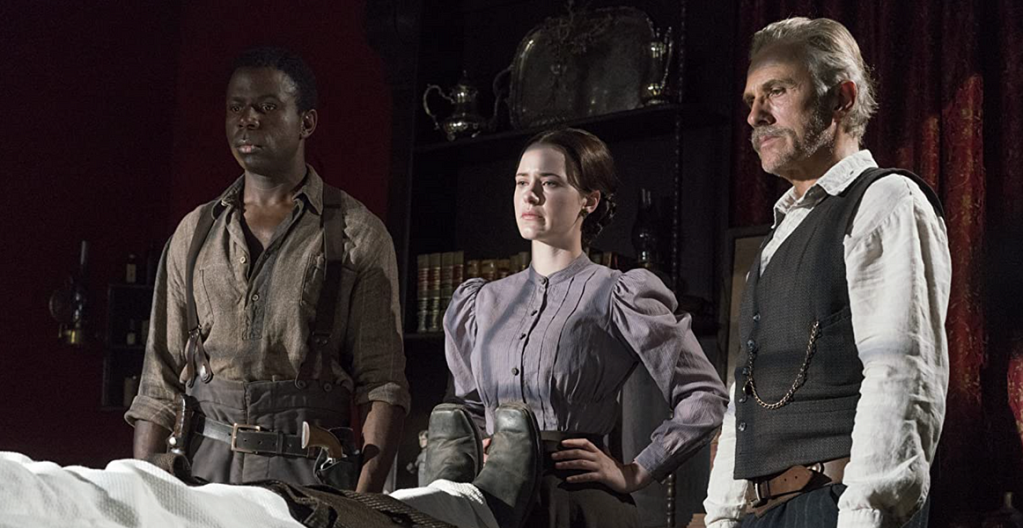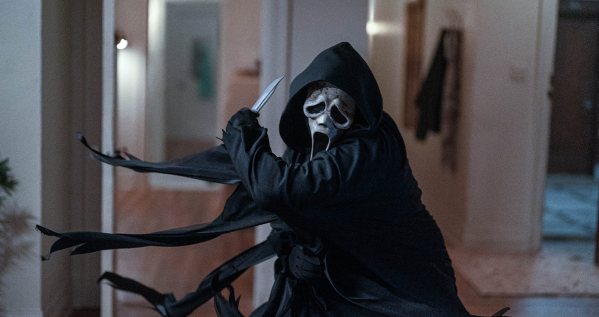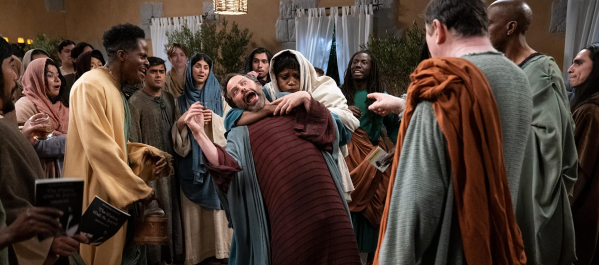1897. America’s first full century is coming to an end. Technological innovations like railroads, telegraphs, rapid-firing weapons, and Edison’s inventions are making America smaller and more manageable. Yet in the New Mexico Territory, encroaching modernity seems distant and irrelevant. Even more so in old Mexico, the setting for a new Western, Dead for a Dollar.
Here, the way of the gun still rules, and a wanderer like Max Borlund (Christoph Waltz) can make a career out of bounty hunting, distributing a lawful form of frontier justice by working for a fee but abiding by a certain code. His natural enemies, too, can live briefly but successfully as antiquated assassins, like Joe Cribbens (Willem Dafoe) does, a chip on his shoulder since Borlund put him behind bars. Even so, this life cannot continue forever.
As Borlund stalks this beautiful wasteland, a wealthy businessman, Martin Kidd (Hamish Linklater), contracts his services. The mission appears simple. Kidd’s wife, Rachel (Rachel Brosnahan), has been kidnapped by Elijah Jones (Brandon Scott), an AWOL American Buffalo Soldier—a nickname for a member of an all-black regiment— who has absconded over the Mexican border. Kidd wants her back. The Army lends Max another buffalo soldier, Sgt. Poe (Warren S.L. Burke), to help.
Borlund soon learns that this hostage scenario is a lie, and that Rachel’s husband intends to kill her. Now Max must choose: continue his life of bounty hunting without question or use his talents to side with civilization—two black men escaping subjugation, a restless woman from the East fleeing familial neglect and domestic abuse to find respect, a Mexican chief magistrate protecting his town, and townspeople seeking their living—against wilder, crueler forces from times past, present, and future—an honorable Texas gunman, a Mexican crime lord, and a shady California businessman with political aspirations.
Dead for a Dollar is a B-movie that resembles a spaghetti Western in basic plot and setting. There is even a 1968 Italian Western called Dead for a Dollar, and the title recalls Sergio Leone’s famous “Dollars Trilogy.” Dead for a Dollar also resembles the films of director Walter Hill’s mentor, Sam Peckinpah—think the B-Western Ride the High Country or The Westerner miniseries. But Hill’s cinema does not contain Leone’s cynicism toward humanity or Peckinpah’s pessimism about late civilization. No, the filmmaker Hill most resembles in Dead for a Dollar is the king of 1950s westerns, Budd Boetticher, to whom Hill dedicates his latest picture.
With a few tweaks, one may easily imagine Dead for a Dollar as part of Boetticher’s universe, especially the Ranown cycle of Westerns with Randolph Scott. It is not difficult to see Randolph Scott as Borlund, Lee Marvin as Cribbens, John Carroll as Martin Kidd, Gail Russell as Rachel Kidd, etc. Like Boetticher, Hill often works in genre territory, has a sense of humor and wit, is a director with traditional aims but bold vision, possesses a strong moral and spiritual foundation, and fills his films with ethical and philosophical debates between characters who constantly measure each other up. Uninterested in reconstructing genre, Hill attempts, alternatively, to elevate it, abhorring postmodern contempt, cynicism, and irony.
Dead for a Dollar’s universe is deeply moral. The characters have codes to follow. The ways they interact with these universal and individual laws and the world around them affect their futures. Actions, virtues, and vices determine spiritual and physical consequences. Borlund’s adherence to his bounty hunter’s code protects him, while his worldview informs him whether to continue adhering or to break away. Cribbens knows all men must die, so they ought to live honorably. The slimy Martin Kidd dodges in and out of both God’s and man’s laws; he cannot end well. Rachel, Elijah, and Poe all want different kinds of freedom; they are principally free in their minds, but their prudence or imprudence determines their free reality. The gods reward bravery, commitment, community, compassion, consistency, devotion, honesty, leadership, and perseverance. As in the classic literature Hill loves—Ernest Hemmingway, Samuel Johnson, Shakespeare, Homer, and the Holy Bible—men receive their just deserts.
As a storyteller, Walter Hill’s beloved classics guide and influence him. Hill has often traced his influences from Peckinpah to Akira Kurosawa to John Ford to D.W. Griffith to Charles Dickens. Like Ford invoking Homer in The Searchers, Hill presents Dead for a Dollar’s protagonist Borlund as an Odysseus, far from home and civilization, similar to the historical figure Chris Madsen after whom Hill modeled Max. Dead for a Dollar explores other common Hill interests as well, including national identity, gender complications, and differences and relations in class, ethnicity, and race—debated within the story’s historical context.
Most of Dead for a Dollar meets Hill’s ambition, but it was perhaps unfortunately produced on the cheap. The pacing feels jarring in the first several minutes, as we are introduced to the story and characters too briskly and some scenes begin and end too abruptly. Other scenes deserved another take or more care, with occasional mistakes popping up in the acting, cinematography, editing, props use, and visual effects. The music is largely average.
Nevertheless, these issues should not mar an otherwise excellent film beyond appreciation, and its oddities do even out with a rewatch. Dead for a Dollar spotlights some of the best character actors working today. Hill’s dialogue remains sharp, and he propels the story—each character serving an integral purpose—to a finale where various plot threads click into place like a good poem, with surprises for the characters and audience. The plotting aptly takes time where it must. The violence feels frightening and impactful, a Hill trademark. Place names and dates situate us in history. Lloyd Ahern II’s cinematographic choices always suit Hill’s intentions, and reminiscent of the Coens’/Roger Deakins’ pioneering of digital color correction techniques in O Brother, Where Art Thou?, Dead for a Dollar’s severe sepia tint effectively illustrates the American Southwest’s sun stabbing everything, blinding inhabitants, scorching earth. There is much to appreciate here.
Yes, Dead for a Dollar is low-budget. Even its distributors apparently consider it a second-tier non-event—though the film premiered at the Venice Film Festival, they have limited its theater run and released it day-and-date on video on demand. Hill deserves better. Yet as he and his fellow New Hollywood directors know, amid a big-budget blockbuster bloat and corporate filmmaking period, good B-movies—those that transcend their situation like Boetticher’s—can be a necessary corrective. Time will tell whether Dead for a Dollar transcends. Many of Hill’s works have. For now, Dead for a Dollar is definitely an idiosyncratic movie worth watching.








Please note that we at The Dispatch hold ourselves, our work, and our commenters to a higher standard than other places on the internet. We welcome comments that foster genuine debate or discussion—including comments critical of us or our work—but responses that include ad hominem attacks on fellow Dispatch members or are intended to stoke fear and anger may be moderated.